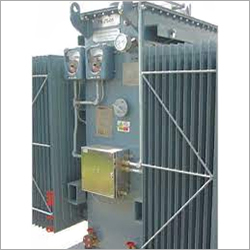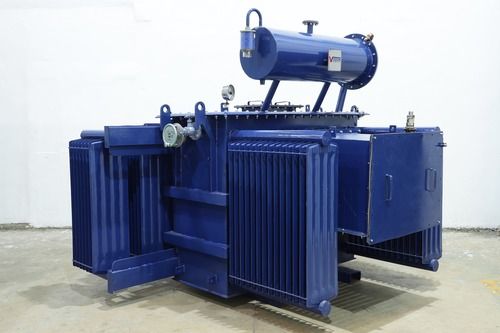Industrial Power Transformer
300000 INR/Unit
Product Details:
- Material MS
- Output AC
- Frequency (MHz) 50 Hertz (HZ)
- Click to View more
X
Industrial Power Transformer Price And Quantity
- 01 Unit
- 300000 INR/Unit
Industrial Power Transformer Product Specifications
- 50 Hertz (HZ)
- MS
- AC
Industrial Power Transformer Trade Information
- 10 Unit Per Week
- 5-7 Days
Product Description
An industrial power transformer is a critical electrical device used to transfer electrical energy between different voltage levels within industrial power systems. These transformers play a crucial role in power distribution networks, helping to ensure efficient transmission and distribution of electricity while maintaining appropriate voltage levels for various industrial applications.
Industrial Power Transformer Specifications:
1. Cooling Type: OLTC / RTCC
2. Secondary Voltage: Upto 1100 V
3. Supply Frequency: 60 Hz
4. Standards: IS-1180
5. Insulation Class: A, B
6. Power: 63 KVA to 2500 KVA
7. Number of Phase: 3-Phase
8. Winding Material: Copper
Key features and aspects of industrial power transformers include:
1. Voltage Transformation: Industrial power transformers are designed to step up or step down the voltage levels of electricity. They can increase voltage for long-distance transmission, reducing losses, or decrease voltage for local distribution and safe usage.
2. Core and Windings: The transformer's core is typically made of laminated steel sheets to reduce core losses due to eddy currents. Windings are copper or aluminum coils wound around the core. Primary windings receive the input voltage, while secondary windings deliver the transformed output voltage.
3. Cooling Systems: Transformers generate heat due to energy losses, and cooling systems are essential to prevent overheating. Common cooling methods include oil cooling (using transformer oil), air cooling (natural or forced), and water cooling.
4. Insulation: Proper insulation is crucial to prevent electrical breakdown between windings and core, ensuring safety and reliable operation.
5. Power Ratings: Industrial power transformers come in various power ratings, ranging from a few kilovolt-amperes (kVA) for small installations to several megavolt-amperes (MVA) for large industrial complexes.
6. Efficiency: Transformers are designed to be as efficient as possible, with the aim of minimizing energy losses during the voltage transformation process.
7. Isolation and Grounding: Transformers provide electrical isolation between primary and secondary circuits, which is vital for safety and reducing the risk of electrical shock. Proper grounding is also essential to maintain a stable reference point for the system.
8. Monitoring and Protection: Modern industrial power transformers are equipped with monitoring and protection systems. These systems track parameters such as temperature, oil level, and load conditions, triggering alarms or shutdowns in case of abnormal operating conditions.
9. Types: There are different types of industrial power transformers, including distribution transformers (used in distribution networks), power transformers (used in transmission systems), autotransformers (single-winding transformers), and special-purpose transformers for specific applications.
10. Maintenance: Regular maintenance is crucial to ensure the longevity and proper functioning of industrial power transformers. This includes oil testing, insulation testing, and visual inspections.
Applications of Power Transformer:
1. Electric Power Transmission: Power transformers are used in high-voltage transmission systems to step up the voltage for long-distance transmission. This reduces transmission losses, making it more efficient and cost-effective to transport electricity over vast distances.
2. Electric Power Distribution: In distribution networks, power transformers step down the high voltage from transmission lines to lower voltages suitable for local distribution to homes, businesses, and industrial facilities.
3. Industrial Facilities: Industrial complexes often require different voltage levels for various processes. Power transformers are used to supply the appropriate voltage levels to meet the needs of industrial machinery and equipment.
4. Renewable Energy Integration: Power transformers are essential in renewable energy systems, such as wind farms and solar power plants. They step up the voltage of the generated electricity for efficient transmission to the grid.
5. Substations: Power transformers are a key component of electrical substations, where they help manage voltage levels between different parts of the power grid, ensuring stable and reliable power distribution.
6. Railways and Transportation: Power transformers are used in electric rail systems to provide the necessary voltage levels for trains to operate efficiently and safely.
7. Commercial Buildings: Commercial buildings require electrical power at specific voltage levels. Power transformers are used to step down the voltage from the main power supply to the required levels for lighting, HVAC systems, and other equipment.
8. Data Centers: Data centers require a stable and reliable power supply. Power transformers help ensure consistent power delivery to critical IT infrastructure.
9. Mining Operations: Mining facilities often require power at remote locations. Power transformers are used to step up or down voltages based on the specific requirements of mining equipment.
10. Oil and Gas Industry: Power transformers are used in the oil and gas sector for various applications, including powering drilling rigs, refineries, and pipelines.
11. Emergency Backup Systems: Power transformers can be integrated into backup power systems to provide power during outages, ensuring continuity of critical operations in hospitals, emergency services, and other essential facilities.
12. Isolation and Grounding: Power transformers are used to provide electrical isolation and grounding in sensitive environments, reducing the risk of electrical hazards and ensuring safety.
13. HVDC Transmission Systems: High-voltage direct current (HVDC) transmission systems use power transformers to convert AC to DC for efficient long-distance transmission of electricity.
14. Interconnecting Power Systems: Power transformers are used at interconnections between different power systems or countries to facilitate cross-border power exchange.
15. Voltage Regulation: Power transformers with on-load tap changers can be used to adjust the output voltage level to maintain consistent voltage levels in the system.
FAQ:
1. What is a power transformer?
Ans: A power transformer is an electrical device that transfers electrical energy between different voltage levels. It consists of primary and secondary windings wound around a core and is used to step up or step down voltage for efficient transmission and distribution of electricity.
2. How does a power transformer work?
Ans: A power transformer works on the principle of electromagnetic induction. When an alternating current flows through the primary winding, it creates a changing magnetic field in the core. This changing magnetic field induces a voltage in the secondary winding, leading to voltage transformation.
3. What are the types of power transformers?
Ans: There are several types of power transformers, including distribution transformers, power transformers, autotransformers, instrument transformers, and specialty transformers for specific applications.
4. What is the purpose of voltage transformation in a power transformer?
Ans: Voltage transformation serves two primary purposes: stepping up voltage for long-distance transmission to reduce losses and stepping down voltage for safe distribution and utilization in homes, businesses, and industries.
5. What are the cooling methods used in power transformers?
Ans: Power transformers can be cooled using methods like oil cooling, air cooling (natural or forced), and water cooling. These methods help dissipate heat generated during transformer operation.
6. How are power transformers rated?
Ans: Power transformers are rated based on their power-handling capacity, usually measured in kilovolt-amperes (kVA) or megavolt-amperes (MVA). The rating indicates the maximum power the transformer can handle without exceeding its design limits.
7. What is the importance of insulation in power transformers?
Ans: Insulation in power transformers prevents electrical breakdown between windings and core, ensuring safe and reliable operation. Proper insulation materials and techniques are crucial to maintaining the transformer's performance and lifespan.
8. Why are monitoring and protection systems necessary for power transformers?
Ans: Monitoring and protection systems help track various parameters such as temperature, oil level, and load conditions. These systems provide early warnings and trigger alarms or shutdowns in case of abnormal operating conditions, preventing potential failures and accidents.
9. How do power transformers contribute to energy efficiency?
Ans: Power transformers contribute to energy efficiency by minimizing losses during the voltage transformation process. Higher voltage levels during transmission reduce the current required, leading to lower I2R (resistive) losses.
10. What is the lifespan of a power transformer?
Ans: The lifespan of a power transformer can vary based on factors such as design, quality, maintenance, and operating conditions. Well-maintained transformers can have a lifespan of several decades.
11. Can power transformers be used in both AC and DC systems?
Ans: Power transformers are designed for AC (alternating current) systems. However, they can be used in HVDC (high-voltage direct current) systems with appropriate modifications and additional components.
12. What are tap changers in power transformers?
Ans: Tap changers are devices in power transformers that allow for the adjustment of the transformer's output voltage. On-load tap changers enable voltage regulation without interrupting the transformer's operation.
13. Are power transformers used in renewable energy systems?
Ans: Yes, power transformers are used in renewable energy systems like wind farms and solar power plants. They help step up the voltage of generated electricity for efficient transmission to the grid.
14. How are power transformers tested and maintained?
Ans: Power transformers are tested through various methods including insulation resistance tests, turns ratio tests, and partial discharge tests. Regular maintenance includes oil testing, visual inspections, and preventive maintenance tasks.
15. Can power transformers explode?
Ans: While rare, power transformers can experience failures that result in explosions or fires. Adequate maintenance, monitoring, and protection systems help minimize the risk of such incidents.
Enter Buying Requirement Details
 English
English Spanish
Spanish French
French German
German Italian
Italian Chinese (Simplified)
Chinese (Simplified) Japanese
Japanese Korean
Korean Arabic
Arabic Portuguese
Portuguese








 Contact Us
Contact Us Send Inquiry
Send Inquiry Send SMS
Send SMS Call Me Free
Call Me Free